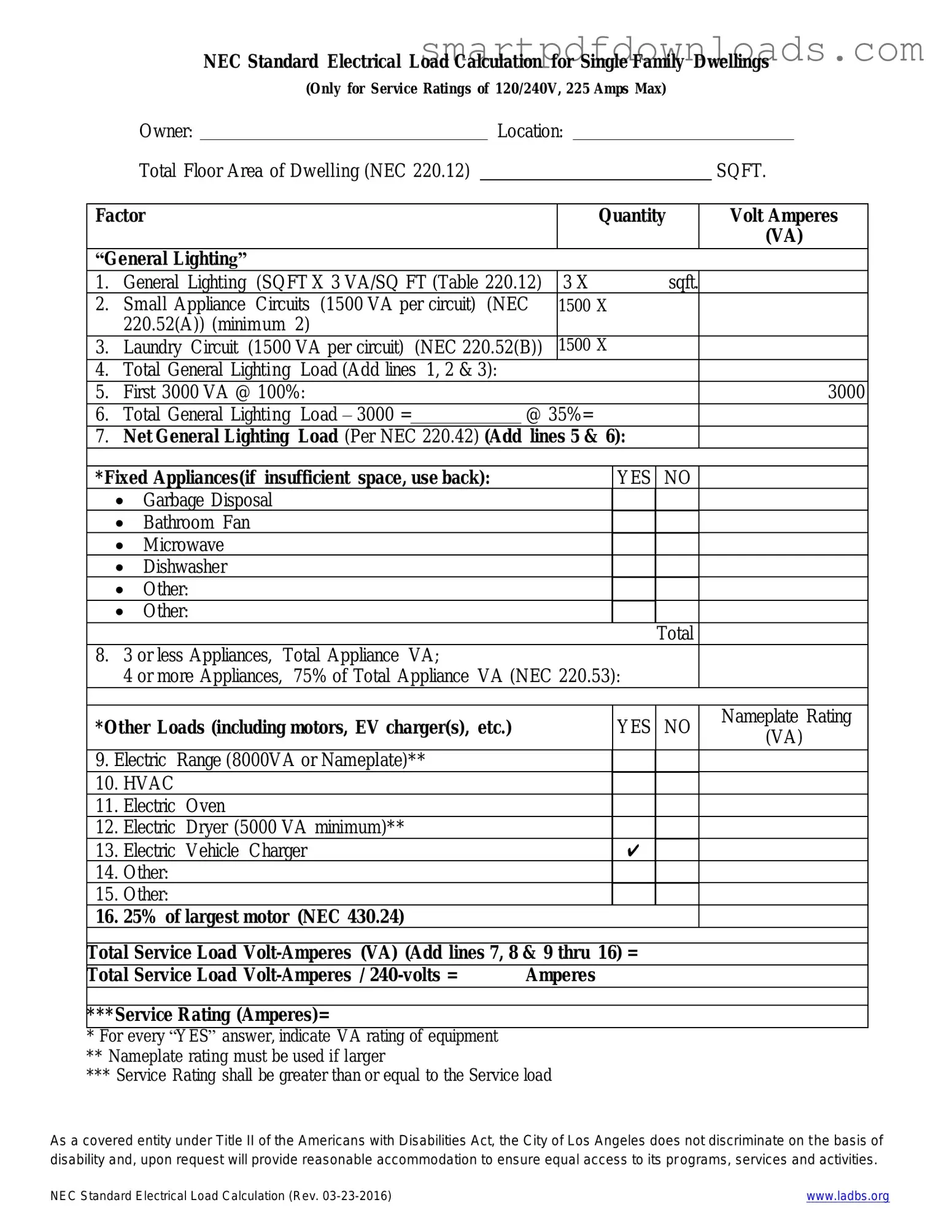
NEC Standard Electrical Load Calculation for Single Family Dwellings
(Only for Service Ratings of 120/240V, 225 Amps Max)
|
|
Owner: |
|
|
|
|
Location: |
|
|
|
|
|
|
|
Total Floor Area of Dwelling (NEC 220.12) |
|
|
|
|
|
|
|
|
|
SQFT. |
|
|
|
|
|
|
|
|
|
|
|
|
|
|
|
Factor |
|
|
|
|
|
|
|
|
Quantity |
|
|
Volt Amperes |
|
|
|
|
|
|
|
|
|
|
|
|
|
|
|
|
(VA) |
|
|
|
|
|
|
|
|
|
|
|
|
|
|
“General Lighting” |
|
|
|
|
|
|
|
|
|
|
|
|
|
1. |
General Lighting (SQFT X 3 VA/SQ FT (Table 220.12) |
3 X |
sqft. |
|
|
|
2. |
Small Appliance Circuits (1500 VA per circuit) |
(NEC |
1500 X |
|
|
|
|
|
220.52(A)) (minimum 2) |
|
|
|
|
|
|
|
|
|
|
|
3. |
Laundry Circuit (1500 VA per circuit) (NEC 220.52(B)) |
1500 X |
|
|
|
|
4. |
Total General Lighting Load (Add lines 1, 2 & 3): |
|
|
|
|
|
|
|
|
5. |
First 3000 VA @ 100%: |
|
|
|
|
|
|
|
|
|
3000 |
6. |
Total General Lighting Load – 3000 = |
|
|
@ 35%= |
|
|
|
|
|
|
|
|
|
|
|
|
|
|
7. |
Net General Lighting Load (Per NEC 220.42) (Add lines 5 & 6): |
|
|
|
|
|
|
|
|
|
|
|
|
*Fixed Appliances(if insufficient space, use back): |
|
|
YES |
NO |
|
|
|
|
Garbage Disposal |
|
|
|
|
|
|
|
|
|
|
|
|
|
|
Bathroom Fan |
|
|
|
|
|
|
|
|
|
|
|
|
|
|
Microwave |
|
|
|
|
|
|
|
|
|
|
|
|
|
|
Dishwasher |
|
|
|
|
|
|
|
|
|
|
|
|
|
|
Other: |
|
|
|
|
|
|
|
|
|
|
|
|
|
|
Other: |
|
|
|
|
|
|
|
|
|
|
|
|
|
|
|
|
|
|
|
|
|
|
|
|
|
|
Total |
|
|
|
8. |
3 or less Appliances, |
Total Appliance VA; |
|
|
|
|
|
|
|
|
|
|
|
|
4 or more Appliances, |
75% of Total Appliance VA (NEC 220.53): |
|
|
|
|
|
|
|
|
|
|
|
|
|
|
|
|
|
|
|
|
|
*Other Loads (including motors, EV charger(s), etc.) |
|
|
YES |
NO |
|
Nameplate Rating |
|
|
|
(VA) |
|
|
|
|
|
|
|
|
|
|
|
|
|
|
|
|
|
|
|
|
|
|
|
|
|
|
|
|
|
9. Electric |
Range (8000VA or Nameplate)** |
|
|
|
|
|
|
|
|
|
|
|
10. HVAC |
|
|
|
|
|
|
|
|
|
|
|
|
|
|
|
11. |
Electric |
Oven |
|
|
|
|
|
|
|
|
|
|
|
|
|
12. |
Electric |
Dryer (5000 VA minimum)** |
|
|
|
|
|
|
|
|
|
|
|
13. |
Electric |
Vehicle Charger |
|
|
|
|
|
✔ |
|
|
|
|
|
14. |
Other: |
|
|
|
|
|
|
|
|
|
|
|
|
|
|
|
15. |
Other: |
|
|
|
|
|
|
|
|
|
|
|
|
|
|
|
16. |
25% of largest motor (NEC 430.24) |
|
|
|
|
|
|
|
|
|
|
|
|
|
|
|
|
Total Service Load Volt-Amperes (VA) (Add lines 7, 8 & 9 thru 16) = |
|
|
|
|
Total Service Load Volt-Amperes / 240-volts = |
|
|
Amperes |
|
|
|
|
***Service Rating (Amperes)=
*For every “YES” answer, indicate VA rating of equipment
**Nameplate rating must be used if larger
***Service Rating shall be greater than or equal to the Service load
As a covered entity under Title II of the Americans with Disabilities Act, the City of Los Angeles does not discriminate on t he basis of disability and, upon request will provide reasonable accommodation to ensure equal access to its programs, services and activities.
NEC Standard Electrical Load Calculation (Rev. 03-23-2016) |
www.ladbs.org |

